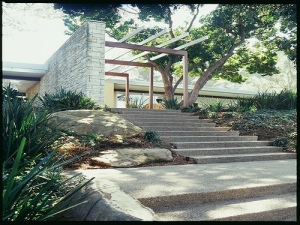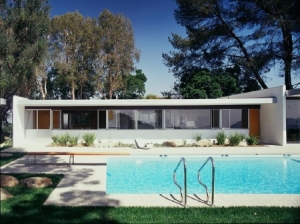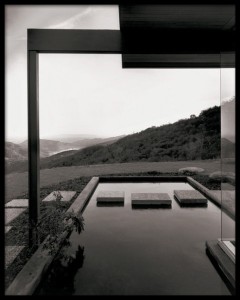Few would question that architect Richard Neutra was one of the preeminent modernist masters of our time. Some of his most famous works – the Lovell House, the Strathmore Apartments, the Kaufmann Desert House – are considered museum-quality treasures to this day. He had the unique distinction of being featured on the cover of Time Magazine in 1949 – before some of his best works were even on the drawing board. So does that mean his houses should be faithfully restored and impeccably maintained in their original state, frozen in time as the master created them? Or are they homes for the living that need to evolve and adapt to ever-changing lifestyles and to remain viably marketable? (Especially when the alternative is, too often, the wrecking-ball.)
 No house has energized this debate more then Neutra’s magnificent Singleton House in the Bel Air neighborhood of Los Angeles. Built in 1959 for the wealthy industrialist Henry Singleton (Teledyne Corp.), and purchased in 2004 by the hair-care tycoon Vidal Sassoon for a reported $6 million, the house was extensively renovated and reconfigured by his wife Ronnie for an attempted “flip” project during the height of the real estate boom. The results, unveiled when the house hit the market in 2008 for an eye-popping $24.5 million, were nothing less than controversial. The milder reviews called the renovation “an act of architectural vandalism” and “hostile to Neutra’s entire vision”.
No house has energized this debate more then Neutra’s magnificent Singleton House in the Bel Air neighborhood of Los Angeles. Built in 1959 for the wealthy industrialist Henry Singleton (Teledyne Corp.), and purchased in 2004 by the hair-care tycoon Vidal Sassoon for a reported $6 million, the house was extensively renovated and reconfigured by his wife Ronnie for an attempted “flip” project during the height of the real estate boom. The results, unveiled when the house hit the market in 2008 for an eye-popping $24.5 million, were nothing less than controversial. The milder reviews called the renovation “an act of architectural vandalism” and “hostile to Neutra’s entire vision”.
I’ve toured the house and it remains jaw-droppingly stunning. But is it still a Neutra? What Ronnie did would have been considered brilliant in any other house. She essentially flipped the floorplan around. A small kitchen facing the driveway was moved across the hall to the south side of the house and opened-up to take in the commanding views of the pool and sun-filled vista beyond. This is, after all, where we now spend most of our time with family and friends. (In 1959 the kitchen was strictly the domain of servants.) A row of small bedrooms that turned their backs on the pool and view were moved to where the kitchen used to be on the dark side of the house. A small master bedroom tucked off the living room was converted to additional entertaining space with a built-in bar. And a new wing housing a state-of-the-art master suite with spa-style bathrooms and a screening room was added along the far end of the pool. Ronnie did her best to respect the spirit of Neutra by retaining or replicating the many built-ins throughout the house and matching the original materials in the new bathrooms, down to the 50 year-old fixtures still available at Sears.While still retaining the look and feel of Neutra’s original, there is no doubt the house makes better use of the siting and is far more livable than its predecessor. But the question remains – is it still a Neutra? How would the master himself feel about it? How it will stand the test of time is yet to be determined. After two years on the market, it remains unsold despite a price reduction of over $5 million. And the debate rages on.
